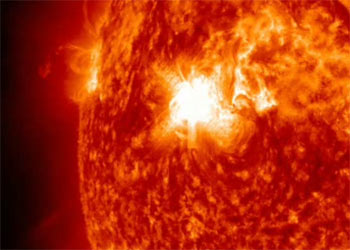On September 24th, Active Region 1302 – a cluster of enormous sunspots – popped off an X-class flare, a powerful event that caused some beautiful aurorae here on Earth.
But the flares don’t have to be so powerful to generate ethereal, magnificent beauty. A day after that biggish event, those sunspots burped again, this time with a lower-power M-class flare. Now, when I say “low power”, it’s not like a firecracker or a car backfiring: the total energy released would still dwarf the combined nuclear might of every country on Earth! By a lot. But for the Sun, that’s considered to be “meh”.
Still, if you get a good view of it, well, it’s still gorgeous. The Solar Dynamics Observatory, orbiting the Earth, has what is essentially a box seat to the Sun, and got this footage of the flare:
[Make sure to set it to at least 720p and make it full screen!]
The flare and prominence – the arcing tower of material – lasted about three hours, and this video shows it at a rate of one frame every minute of real time. The flare pops, and then the fountain erupts from the surface. This gas is ionized (stripped of at least one electron), so it’s highly influenced by the magnetic field of the Sun as well as by its crushing gravity. The material flows up, forming that amazing sheet of roiling gas, reaches the top of its arc, and falls back down.
 Well, it doesn’t fall so much as flow, guided by the enormous strength of the Sun’s magnetic field lines. Mind you, eyeballing from the size of the Sun’s disk, I’d venture this tower of gas is well over 100,000 km (60,000 miles) long! There are millions of tons of gas in it as well, moving dozens of times faster than a rifle bullet. The energies involved are mind-crushing.
Well, it doesn’t fall so much as flow, guided by the enormous strength of the Sun’s magnetic field lines. Mind you, eyeballing from the size of the Sun’s disk, I’d venture this tower of gas is well over 100,000 km (60,000 miles) long! There are millions of tons of gas in it as well, moving dozens of times faster than a rifle bullet. The energies involved are mind-crushing.
Also, if you look to the upper left, you’ll see a smaller prominence loop caught in the act of evolving, with material apparently floating over the solar surface, then flowing back down as well.
I wrote a description of how sunspots produce flares and (sometimes) coronal mass ejections, and about prominences before. NASA has a nice guide to solar flare classification, too.
Video credit: NASA/SDO/Helioviewer.org.
Related posts:
- The Sun lets loose a HUGE explosion
- For your viewing pleasure: Active Region 1302
- Solar storm tracked all the way from the Sun to Earth
- Awesome X2-class solar flare caught by SDO